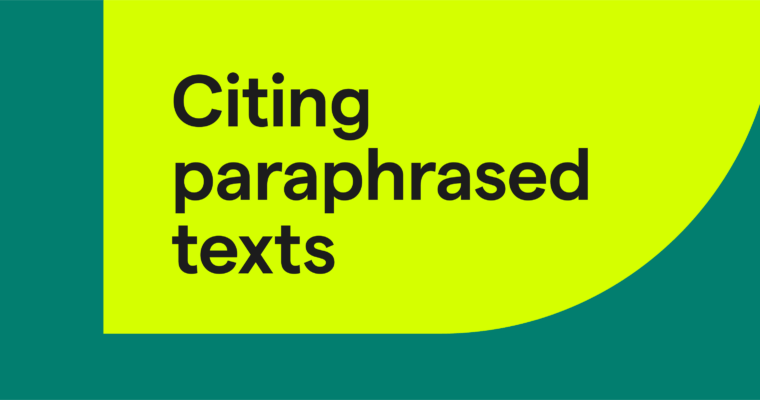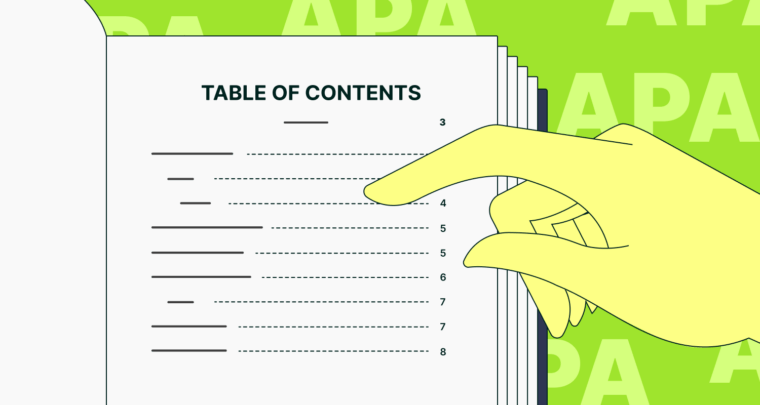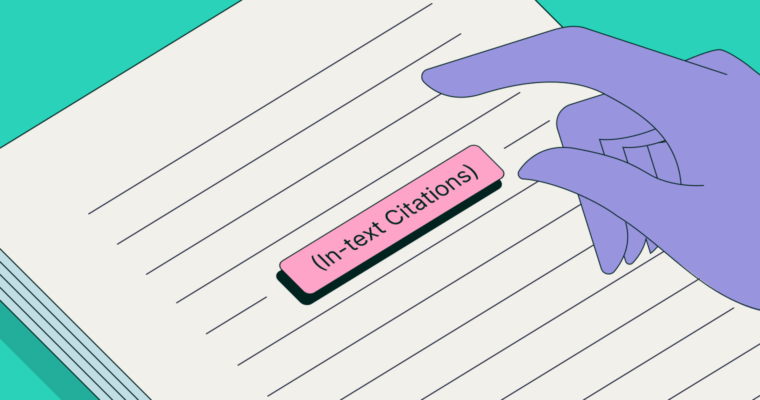
APA format is a set of formatting and citation guidelines for how an academic paper should look, similar to other styles like Chicago or MLA. APA format is usually preferred for subjects in the social sciences, such as psychology, sociology, anthropology, criminology, education, and occasionally business.
Because each style is different, you may need to learn new formatting or citation rules depending on what subject you’re writing about. Below, we explain everything you need to know about how to write a paper in APA, including formatting guidelines, style choices like whether to use the Oxford comma, and how to cite sources. We also give plenty of APA citation examples.
What is APA format?
APA format, also known as APA style, is one of the styles used in academic writing. Specifically, it’s used in psychology, sociology, anthropology, and the other social sciences.
APA style was developed by the American Psychological Association in 1929. The team of academics from the psychology, anthropology, and business fields who developed APA style sought to create standardized style guidelines for scientific writing that would make academic papers in their fields easier for people to read and comprehend. Today, The Publication Manual of the American Psychological Association is in its seventh edition.
When to use APA format
Use APA format for every piece of academic writing you do for your social sciences, engineering, and education courses. This includes research papers, essays, lab reports, and other kinds of reports. If you’re ever unsure if an assignment needs to be in APA format, just ask your instructor.
There’s no need to use APA format in your outline or first draft unless you’re required to hand it in for your instructor’s feedback or approval. Basically, any part of your assignment that you hand in needs to be in APA format. This includes the final draft of your paper as well as your literature review and, if applicable, research proposal.
APA vs. MLA and Chicago
APA format is one of the most common styles for writing school papers, along with MLA and Chicago. Each style has its own rules for how to format text and pages, how to write citations, and what vocabulary you can and cannot use.
Which format you use depends on the subject. As mentioned, APA is preferred for the social sciences, while MLA is used for the humanities like philosophy or literature, and Chicago is used for history.
In terms of style, APA places a heavy emphasis on dates, specifically the year a work was published. By contrast, MLA focuses more on authorship, while Chicago specializes in footnotes and endnotes.
How to set up your paper in APA format
APA formatting rules
1 Print your assignment on 8½-by-11-inch paper.
2 Leave a 1-inch margin along all sides of the paper.
3 Include a header on each page of your paper. This is also known as the running head. For student papers, the running head contains simply the page number, flush right. For a professional paper, it includes the paper’s title (shortened to fifty characters or fewer), flush left, then the page number, flush right.
4 Include page numbers for every page in an APA work. This number is flush right in the page’s header. The title page is considered page 1.
5 Although APA format does not require that writers use specific fonts, it’s best to use one of its recommended fonts. These include 12-point Times New Roman, 10-point Lucida, 11-point Calibri, and 11-point Arial.
6 Your paper must have a title page. Include the paper’s title and names of each author, as well as the running head on professional papers, but not student papers. Student papers should include your affiliation (the school you attend), the course number, instructor name, and assignment due date, while professional papers should include the affiliations of each author (such as their university) and an author note.
7 Write the list of citations on a separate page titled “References,” bolded and centered. This page comes after the body text but before any final tables or appendices.
8 Double-space your paper, including the title, abstract, and reference list pages.
9 Some APA papers have an abstract page, immediately following the title page. This is a quick summary of the paper—no more than 250 words—written either in a paragraph style or using a structured Objective / Method / Results / Conclusion format. The title “Abstract” appears in bold, centered at the top of the page, and no indentation is used for the text.
10 On the first page of text (after the title and abstract pages), write the paper’s title in title case, bold and centered.
11 Paragraph indentations are half an inch. Also indent the first line of each new footnote. Entries on the reference list page use a hanging indent, which means you indent every line except the first.
APA styling rules
1 APA prioritizes continuity, flow, conciseness, and clarity for the sake of easy-to-understand writing. A formal and direct tone is preferred.
2 Do not use contractions or colloquialisms.
3 Feel free to refer to yourself in the first person if you’re the one who did the research.
4 Avoid the editorial we, which functions as everyone, as in, “We don’t fully understand how self-aware infants are.”
5 Use the Oxford comma, aka the serial comma, when you’re using APA format.
6 Use title case for headings, as well as table and figure titles. However, use sentence case for the titles of works in the reference list.
7 Spell out numbers zero through nine and use numerals for 10 and above. However, always use numerals for numbers that come before a unit of measurement (e.g., 4 cm); that show a position in a series after a noun (year 1, grade 3, chapter 2); or that represent time, dates, ages, scores, points, money, or numbers themselves (e.g., 6 days, 9-year-old, $1, the number 5).
8 Use numerals for all numbers that represent statistical or mathematical functions, such as ratios, decimals, and percentages (e.g., 20:1, 8.33, 7%, 3 times as many). However, spell out numbers in common fractions (one-fifth, two-thirds).
9 Spell out numbers if they begin a sentence, title, or heading.
How to cite sources in APA: citation examples
Citation formatting is an important component of any academic style. In APA format, references need to be acknowledged where they appear in the text (known as in-text citations) and listed on a distinct page known as the reference list page. Because it was developed primarily for the social sciences, APA format has straightforward, logical citation guidelines for referencing sources.
According to the Publication Manual of the American Psychological Association, you must cite the people “whose ideas, theories, or research have directly influenced your work.” Most papers will have a lot of citations, sometimes even two in the same sentence.
How to present evidence and quotes in APA
When presenting ideas that are not your own, you can either paraphrase or use direct quotes.
Paraphrasing means writing another author’s text in your own words. Typically it involves more than just using synonyms; it’s best to change the sentence structure as well. However, you must make sure the changes from the original text are significant, otherwise your paper won’t pass a plagiarism checker.
If the words from the original source are perfect as they are, you can also directly quote a passage in your paper. However, excessive quotes can make a paper hard to read or appear unoriginal, so only use them when necessary. When you do use direct quotes, try to keep them as short as possible by cutting out needless words at the beginning and end.
Whether you use paraphrasing or direct quotes, you still need to cite the source and include it in the reference list.
In-text citations in APA
APA format uses in-text citations to credit others’ works, as opposed to footnotes or other methods. Specifically, it uses an author-date citation system, which includes the main author’s surname and the year of publication.
There are two types of in-text citations: parenthetical and narrative. Parenthetical citations in APA use the author’s surname and the year of publication, separated by a comma and set apart in a pair of parentheses. They appear after the cited idea, ideally at the end of the sentence.
In situations where the future was outside of human control, introverts actually saw improved self-esteem, whereas extroverts showed no difference (Sobol et al., 2021).
Narrative citations are when either the author’s name or year of publication is used in the actual text. Repeating it in the citation would be redundant, so only the missing information is placed in parentheses. However, unlike other citations, this one comes directly after the author’s name.
Sobol and her team (2021) found that introverts saw an improvement in self-esteem during situations they couldn’t control, whereas extroverts showed no difference.
If both the author’s name and the year are given in the text, no citation is needed.
In a 2021 study, Sobol and her team found that introverts saw an improvement in self-esteem in situations they couldn’t control, whereas extroverts showed no difference.
To assist the reader, you can also include the location of the passage cited, such as a page number, chapter, table, figure, or time stamp. These come after the publication year, again separated with a comma. This is necessary when using direct quotes.
The researchers suggested that extroverts were less affected because they “have a strong sense of control over time,” so temporarily losing control didn’t matter much (Sobol, 2021, p. 455).
If a quotation is more than forty words, format it as a block quotation by setting it on a new line and indenting each line half an inch. With block quotes, the in-text citation appears at the end of the quote but after the final period (unlike other citations, which come before the final punctuation).
Footnotes and endnotes in APA
Because of its dedication to in-text citations, APA format uses footnotes much less often than the other styles do. There are only two situations where footnotes are appropriate in APA:
1 Content notes: Content footnotes provide supplemental information that enhances the text but may be too distracting or tangential to include in the body. Even so, content footnotes should be as succinct as possible and contain only one idea each.
2 Copyright attribution: If you’re reproducing another person’s work, such as an image, table, or figure, you’ll need to mention the copyright attribution in a footnote.
Footnotes are marked in the text by a superscript number (1) that is placed at the end of a passage, after any punctuation mark except the dash.
Despite criticism,1 the study furthers psychologists’ understanding of fatalistic time perspective.
The number corresponds to a footnote at the bottom of the page. Each footnote is indented and introduced with the same number used in the text, also superscript.
1 The study used a small sample size of only 104 participants, considered substandard, and all from the same culture (Polish).
Alternatively, you can place the notes on a separate page titled “Footnotes” at the end of the work, after the references page (although technically these would be endnotes because they come at the end of your paper, APA uses “Footnotes” as the title for this section).
APA reference list page
Any source you consult while writing your paper must be mentioned on the reference list. This page serves more or less the same purpose as the works cited page in MLA format, although some particulars about formatting are different.
The reference list appears on a separate page at the end of the work, with the title “References” bold and centered at the top. Each entry should contain, if applicable, the author, year of publication, title of the work, and the location of the source (for example, the website URL or name of the journal).
Names in the reference list are inverted, meaning the surname is written first. The given first name is written next as initials with periods. For multiple authors, list each author in the order they’re listed in the source, not necessarily alphabetical. Place commas in between each name and an ampersand (&) before the last author.
Entries use a hanging indent, which means the first line is not indented, but all subsequent lines are. List the entries in alphabetical order by whatever comes first, usually the author’s surname but sometimes the title if no author is given.
Each type of source has its own particular requirements for what information to include. Below are links to guides on how to format each type of source in APA. However, to give you a general example, your reference list entries should look something like this:
Sobol, M., Przepiórka, A., Meisner, M., & Kuppens, P. (2021). Destiny or control of one’s future? Fatalistic time perspective and self-esteem in extroverts and introverts. The Journal of General Psychology, 149(4), 443–455. https://doi.org/10.1080/00221309.2021.1878486
How to cite different types of sources in APA format
Learning the correct way to write citations for each type of source can get confusing, even if you’ve used APA format before. Below you’ll find links to our individual guides on how to cite each type of source, all for APA format.





